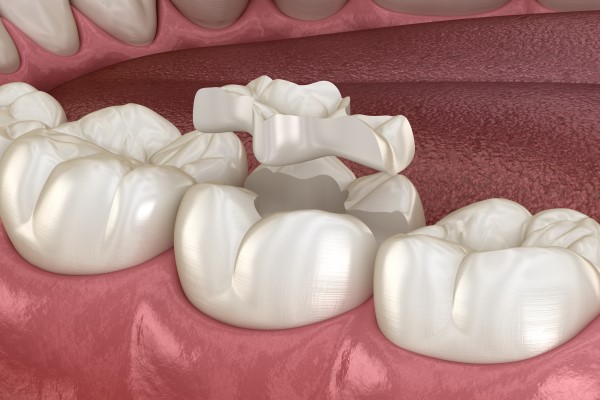When Would a Dentist Recommend a Dental Inlay?

A dental inlay is porcelain, gold, or composite material for repairing dental decay or damage. Your dentist can use this substance to repair a tooth with a type of damage not huge enough for a dental crown. An inlay can restore a healthy dental structure and provide enough support for chewing. If you want to know when your dentist would suggest a dental inlay, here are the details.
What a dental inlay is
A dental inlay is a pre-molded type of filling. A dentist will place an inlay in the center of the affected tooth. This is the common form of restoration for cavities. It concentrates on the central grooves of the tooth. Cavities with this type of filling do not worsen anymore.
The process of getting an inlay is simple and painless. The dentist will use a local anesthetic on the area to ensure the patient’s comfort. Then, the dentist will drill out the decayed parts and clean the cavity. Taking an impression of the top cavity will come next. The dentist will then send the impression to the lab.
An inlay is either composite resin or porcelain. The color always matches the color of the patient’s natural tooth. The effect of this restoration is almost undetectable. Inlays are stronger than regular dental fillings.
When a dentist would recommend a dental inlay
A dentist can suggest the application of an inlay for groove cavities. This is when bacterial activity concentrates on the top chewing surfaces of the back teeth. A dental inlay is for moderate to deep decay in these areas. The back teeth are difficult to clean. They are prone to decay, especially if the patient is fond of sweet treats.
Chipped or cracked teeth can also get an inlay. If a tooth is not repairable with a dental filling yet not enough for a dental crown or root canal procedure, then an inlay can be used. A dentist can recommend an inlay for a damaged tooth with the cusp intact. An inlay can also help a tooth with a weakened dental structure due to a large filling.
Types of inlays
Many patients prefer composite inlays. The material is easy to use. That is why dentists can apply it in one dental visit. A composite dental inlay gives a natural look to the treated tooth. It is almost an invisible restoration.
The most common inlay material is porcelain. Dentists use this to give patients tooth-colored repairs. Porcelain is durable. It is also stain-resistant. Patients do not need to worry about discoloration when consuming colored drinks and foods.
Gold is a high-quality material. Dentists do not use this type of dental inlay that much. Some patients do not like the color of gold, especially on teeth near the front. The high price of this material is due to its wear resistance, strength, and durability.
A dental inlay can restore the damage along the top central grooves of your back teeth
The chewing surfaces of the back teeth are prone to damage. These areas are difficult to clean. That is why cavities form here all the time. Treating the central grooves of a back tooth with an inlay can restore and protect that tooth. An appointment with your dentist can determine which type of dental inlay fits your needs.
Are you considering getting a dental inlay in the Marietta area? Get more information at https://www.mytotaldentistry.com.
Check out what others are saying about our dental services on Yelp: Dental Inlay in Marietta, OH.
Recent Posts
For many patients, Invisalign® treatment is a good alternative to traditional braces. Treatment time is often shorter, and patients can maintain better oral hygiene during the process. This type of orthodontic treatment uses a series of clear aligners to straighten teeth. The patient wears the trays for 20-22 hours a day, only removing them for…
An effective and yet inconspicuous way to straighten the teeth, Invisalign® gives individuals the flexibility to enjoy a wide range of foods while undergoing the teeth straightening process. When compared to traditional braces that come with a long list of what can be eaten and what needs to be avoided, removable alignment trays bring more…
Patients who choose Invisalign® are generally able to maintain a more normal lifestyle than patients wearing traditional braces. Patients with wire-and-bracket braces, or those who had such braces in the past, likely remember at least one instance in which they had to visit the emergency orthodontist to replace a part or fix a broken wire,…
A dental filling is important in achieving good dental health and a painless smile. This dental restoration can seal the tooth and protect it from further decay. Knowing when to get fillings can help you achieve your smile goals earlier. Here are the signs your tooth may need a dental filling right away.Pain often develops…


